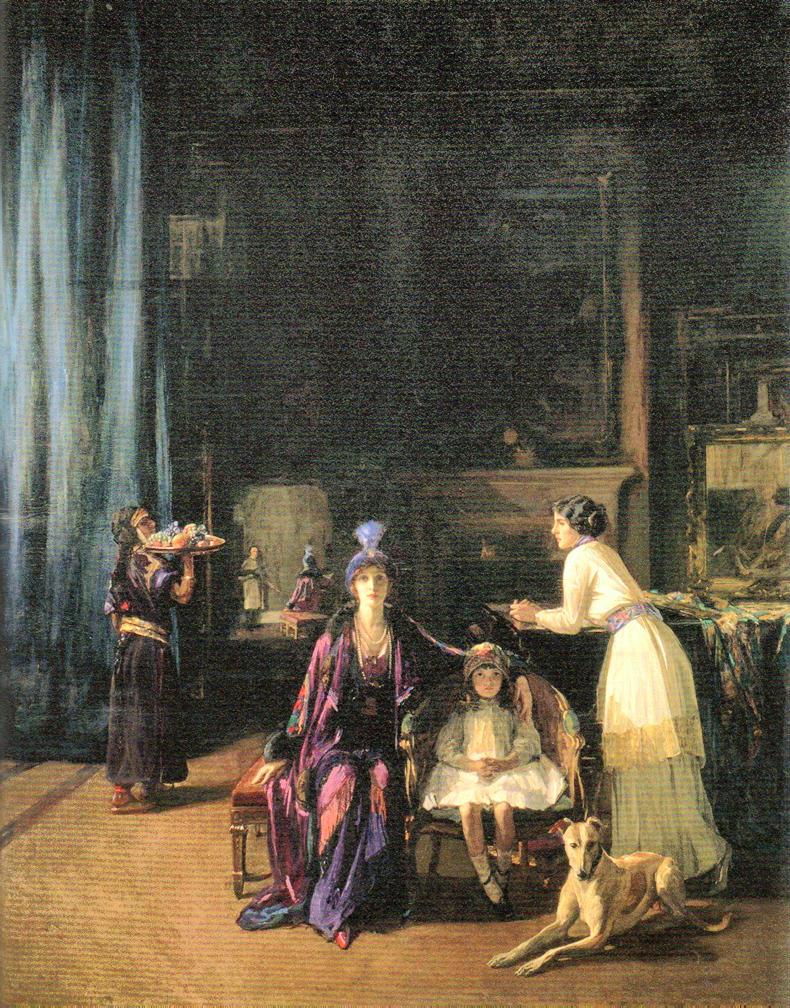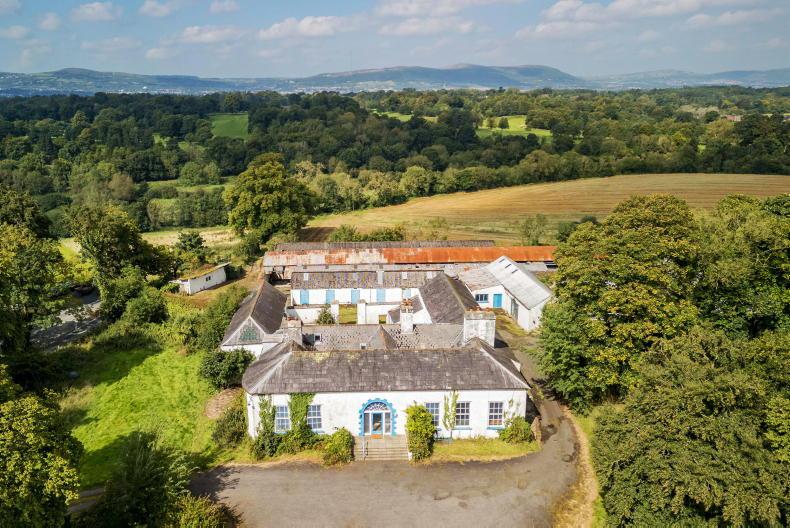Set, as its name would suggest, in Sir John Lavery’s studio at Cromwell Place in London, this enormous canvas is a homage to old master painting and a celebration of Lavery’s status. Begun in 1910, it features Lavery’s second wife Hazel, her daughter Alice from her first marriage, and the artist’s own daughter Eileen by his first wife.
Carrying a fruit-laden salver is the family’s Moroccan maid Aïda, and she, like Lavery’s painting on the back wall, alludes to his long-standing relationship with north Africa. Hazel appears in clothes of richly coloured silk and satin, and a feathered turban.
Lavery based the painting’s composition and many prominent details on Velázquez’s Las Meninas (1656). He imitates Velázquez in placing the family greyhound, Rodney Stone, in the same spot as that occupied by a dog in the 17th-century painting. Other references include the artist’s inclusion of himself, reflected in a mirror, holding his palette and brush.
Lavery invested huge energy and time in the production of this work, amending several elements and enlarging the painting considerably after it was first exhibited in Rome in 1911. The painting was completed in 1913 and now is among the collection in the National Gallery of Ireland.
Born in Belfast in 1856, Sir John Lavery was best known for his portraits and wartime depictions. After the family moved to Scotland he attended Haldane Academy in Glasgow and studied at the Académie Julian in his mid-20s. He returned to Glasgow and in 1888 he was commissioned to paint the state visit of Queen Victoria to the city. This launched his career as a society painter and he moved to London, where he became friendly with James McNeill Whistler who became an influence.
Lavery was appointed an official artist in World War I but ill health and a serious car crash during a bombing raid kept him from fulfilling the role. During the war years he spent time with the Asquith family at their residence where he painted Summer on the River (Hugh Lane Gallery). After the war he was knighted and in 1921 was elected to the Royal Academy.
John and Hazel Lavery’s London home was used by the Irish negotiators during the talks leading to the Anglo-Irish Treaty. After Collins was assassinated, Lavery painted Michael Collins, Love of Ireland, now in the Hugh Lane Gallery in Dublin. In 1929, Lavery made substantial donations of his work to both The Ulster Museum and the Hugh Lane Municipal Gallery and in the 1930s he returned to Ireland. He received honorary degrees from the University of Dublin and Queen’s University Belfast. He was made a freeman of Dublin and Belfast.
Lavery’s first wife, Kathleen MacDermott, died shortly after the birth of Eileen. In 1909 Lavery married Hazel Martyn, an Irish-American beauty who had a daughter Alice Trudeau. Hazel was depicted in more than 400 of her husband’s paintings. Most memorably, Hazel modelled for the emblematic figure of Ireland Lavery painted on commission from the Irish Government, reproduced on Irish banknotes until 1975, and then as a watermark until the introduction of the euro.
Sir John Lavery died in Rossenarra House, Kilmoganny, Co Kilkenny in 1941, aged 84.
Read more
The Front Row: a cultural trip to Cork
The Front Row: the show must go on
Set, as its name would suggest, in Sir John Lavery’s studio at Cromwell Place in London, this enormous canvas is a homage to old master painting and a celebration of Lavery’s status. Begun in 1910, it features Lavery’s second wife Hazel, her daughter Alice from her first marriage, and the artist’s own daughter Eileen by his first wife.
Carrying a fruit-laden salver is the family’s Moroccan maid Aïda, and she, like Lavery’s painting on the back wall, alludes to his long-standing relationship with north Africa. Hazel appears in clothes of richly coloured silk and satin, and a feathered turban.
Lavery based the painting’s composition and many prominent details on Velázquez’s Las Meninas (1656). He imitates Velázquez in placing the family greyhound, Rodney Stone, in the same spot as that occupied by a dog in the 17th-century painting. Other references include the artist’s inclusion of himself, reflected in a mirror, holding his palette and brush.
Lavery invested huge energy and time in the production of this work, amending several elements and enlarging the painting considerably after it was first exhibited in Rome in 1911. The painting was completed in 1913 and now is among the collection in the National Gallery of Ireland.
Born in Belfast in 1856, Sir John Lavery was best known for his portraits and wartime depictions. After the family moved to Scotland he attended Haldane Academy in Glasgow and studied at the Académie Julian in his mid-20s. He returned to Glasgow and in 1888 he was commissioned to paint the state visit of Queen Victoria to the city. This launched his career as a society painter and he moved to London, where he became friendly with James McNeill Whistler who became an influence.
Lavery was appointed an official artist in World War I but ill health and a serious car crash during a bombing raid kept him from fulfilling the role. During the war years he spent time with the Asquith family at their residence where he painted Summer on the River (Hugh Lane Gallery). After the war he was knighted and in 1921 was elected to the Royal Academy.
John and Hazel Lavery’s London home was used by the Irish negotiators during the talks leading to the Anglo-Irish Treaty. After Collins was assassinated, Lavery painted Michael Collins, Love of Ireland, now in the Hugh Lane Gallery in Dublin. In 1929, Lavery made substantial donations of his work to both The Ulster Museum and the Hugh Lane Municipal Gallery and in the 1930s he returned to Ireland. He received honorary degrees from the University of Dublin and Queen’s University Belfast. He was made a freeman of Dublin and Belfast.
Lavery’s first wife, Kathleen MacDermott, died shortly after the birth of Eileen. In 1909 Lavery married Hazel Martyn, an Irish-American beauty who had a daughter Alice Trudeau. Hazel was depicted in more than 400 of her husband’s paintings. Most memorably, Hazel modelled for the emblematic figure of Ireland Lavery painted on commission from the Irish Government, reproduced on Irish banknotes until 1975, and then as a watermark until the introduction of the euro.
Sir John Lavery died in Rossenarra House, Kilmoganny, Co Kilkenny in 1941, aged 84.
Read more
The Front Row: a cultural trip to Cork
The Front Row: the show must go on










SHARING OPTIONS